Welcome to the fascinating world of bluebirds in Europe! From the bright blues of the Kingfisher to the deep hues of the Azure, Europe is home to a rich variety of blue-feathered birds.
As one of the most vibrant and recognizable birds in the world, bluebirds are a beloved sight in European skies. Their feathers, which range from the azure of a brilliant summer sky to the navy of a star-filled night, are as varied as the species themselves.
This guide will provide an overview of the various species of bluebirds found in Europe, as well as some of the interesting facts about them. So, let’s get started on our journey through the world of European bluebirds!
1. Eurasian Blue Tit

The Eurasian blue tit is a small passerine bird that belongs to the tit family, Paridae. It is a small-sized bird that can easily be identified by its striking blue and yellow plumage. The blue tit has a blue cap, which is brighter on males, and a yellow face, neck, and breast.
Its wings and tail are blue with yellow edges, and its back is a mixture of grey, yellow, and blue.
Its small size, around 12-14 cm long, also helps to identify it. The Eurasian blue tit is widespread across Europe and Asia and can be found in a variety of habitats, including woodlands, gardens, and parks.
It is an adaptable species that is able to live in a variety of different environments. It feeds mainly on insects, but will also eat seeds, berries, and nuts.
The blue tit is a sociable bird that is often seen in large flocks, and it is known to have a variety of vocalizations. The Eurasian blue tit is a popular garden bird, and it is also an important species in the study of avian ecology and behavior.
It is a common host of the cuckoo, which lays its eggs in the nests of other species. The blue tit is a highly successful species that is not currently threatened by human activities.
| Kingdom | Animalia |
| Phylum | Chordata |
| Class | Aves |
| Order | Passeriformes |
| Family | Paridae |
| Genus | Cyanistes |
| Species | C. caeruleus |
2. Bluebirds

Bluebirds are a group of birds that live in North America and are medium-sized in size. They are mainly insectivorous or omnivorous, meaning that they feed primarily on insects but also eat other types of food.
They belong to the order of Passerines and the genus Sialia, which is part of the thrush family. Bluebirds are one of the few thrush genera found in the Americas. When it comes to reproduction, bluebirds lay an average of four to six eggs at a time.
The female bluebird will typically build a nest in a tree or bush and lay her eggs in it. After hatching, she will continue to care for the chicks until they are ready to fledge and become independent.
Bluebirds are monogamous and will usually stay with the same partner for life.
| Kingdom | Animalia |
| Phylum | Chordata |
| Class | Aves |
| Order | Passeriformes |
| Family | Turdidae |
| Genus | Sialia |
3. Tit
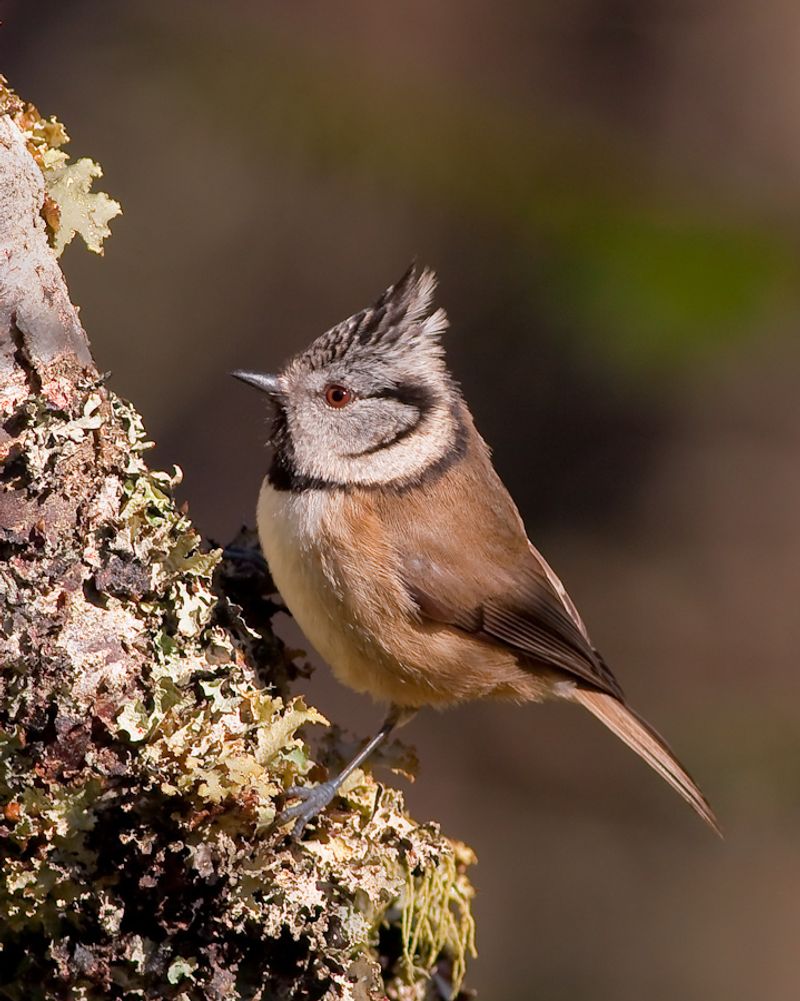
The Paridae is a family of small passerine birds, commonly known as tits, chickadees, and titmice. These birds are found mainly in the Northern Hemisphere and Africa and are typically quite small. They have short, rounded wings and a short, hooked bill.
Most species of Paridae were formerly classified in the genus Parus, which is now thought to include around 60 species. These birds are insectivorous, feeding mainly on small insects and spiders, but they will also eat berries and seeds.
They are often found in pairs or small groups and are quite social. They are known for their curious behavior and their ability to remember where food caches are located.
They are also quite vocal and can produce a variety of sounds, including the characteristic “chick-a-dee” call of the chickadees.
| Kingdom | Animalia |
| Phylum | Chordata |
| Class | Aves |
| Order | Passeriformes |
| Family | Paridae |
4. Cyanistes

Cyanistes is a genus of birds that belongs to the family Paridae, commonly known as the tit family. The family is comprised of small passerine birds which are found throughout the Northern Hemisphere and parts of Africa.
The genus Cyanistes includes species such as the great tit, blue tit, and marsh tit. Cyanistes was previously considered a subgenus of Parus, which is also a genus within the tit family.
However, it is now considered a distinct genus due to genetic and morphological differences between Cyanistes and other genera. Cyanistes species tend to have a predominantly blue-gray coloration on the back and wings, whereas other genera are usually brown or black.
Additionally, Cyanistes has a longer tail and more pointed wings than other tit species.
| Kingdom | Animalia |
| Phylum | Chordata |
| Class | Aves |
| Order | Passeriformes |
| Family | Paridae |
| Genus | Cyanistes |
5. Crow Family
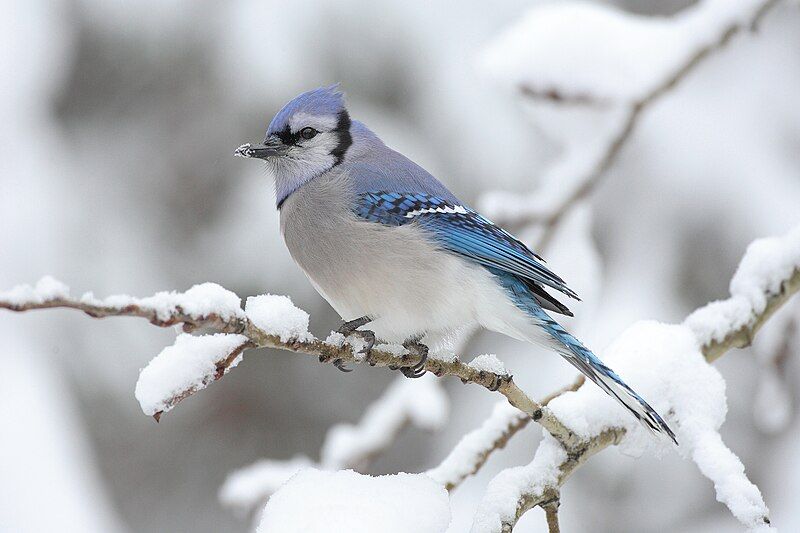
Corvidae is a family of birds that is spread across the world and are known as passerine birds. These birds are known collectively as the crow family or corvids. This family includes crows, ravens, rooks, magpies, jackdaws, jays, treepies, choughs, and nutcrackers.
Currently, there are 135 species of birds that are part of the Corvidae family. These birds are known for their intelligence. They are able to remember and recognize human faces, and can even be taught to talk.
They can craft tools to solve puzzles and have been known to use tactics like distraction and misdirection to steal food from other animals. Corvidae birds are also known for their vocalizations. Depending on the species, they can have a wide range of calls and songs.
They are known to use calls to communicate with each other, as well as to attract mates. The Corvidae family is a diverse one, and each species has its own unique traits that set it apart from the others.
They are all quite adaptable and can be found in a variety of habitats, ranging from forests and mountains to grasslands and even urban areas. They are a vital part of the ecosystem, and their presence helps to keep the balance of nature in check.
| Kingdom | Animalia |
| Phylum | Chordata |
| Class | Aves |
| Order | Passeriformes |
| Family | Corvidae |
6. Common Starling

The common starling is a species of bird belonging to the Sturnidae family. It is known by many different names in different parts of the world, such as the European starling in North America and the starling in Great Britain and Ireland.
It is a medium-sized bird, with a total length of 18-20 cm and a wingspan of 28-31 cm. The upper parts of the bird are brownish black, while the underside is light brown, with white spots. Its bill is black and its legs are yellow.
The common starling is an omnivore, feeding on insects, seeds, fruits, and grains. It is also known to scavenge for food at garbage dumps. It is a highly gregarious species, often forming large flocks of hundreds or even thousands of individuals.
It is found in open habitats such as farmland, parks, and gardens, and is widely distributed across much of the world. The common starling is an important part of many ecosystems, as its droppings are a major source of fertilizer for plants.
It is also an important part of cultural history, appearing in many works of art and literature.
| Kingdom | Animalia |
| Phylum | Chordata |
| Class | Aves |
| Order | Passeriformes |
| Family | Sturnidae |
| Genus | Sturnus |
| Species | S. vulgaris |
7. Common Blackbird
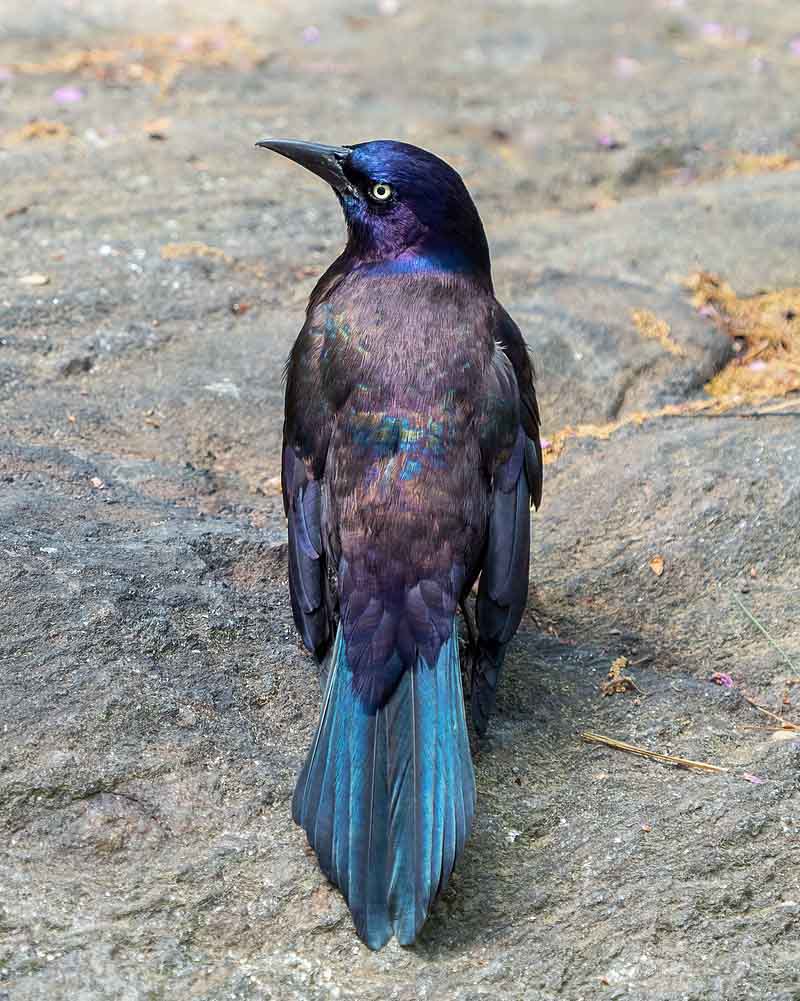
The common blackbird, also known as the Eurasian blackbird, is a species of true thrush that is found in Europe, Asiatic Russia, and North Africa.
This species of bird has also been introduced to Australia and New Zealand, although this can sometimes lead to confusion with a similar-looking local species. The common blackbird is a medium-sized bird, with a wingspan of up to 31 inches.
It is mostly black in color with a dark-brown back and yellow bill. The male has a bright yellow eye-ring and a pale yellowish-white throat. The female is generally duller with a gray-brown throat. The common blackbird is usually found in parks, gardens, farmland, and woodlands.
It feeds mainly on insects, worms, and snails, but also eats fruits and berries. It builds its nest in trees or bushes and may use a variety of materials such as moss, grass, and twigs. The common blackbird is a very sociable bird, with a variety of different calls and songs.
It is often seen in small flocks, and will often join mixed flocks of other species of birds.
It is also a very territorial bird and will defend its territory vigorously. Overall, the common blackbird is a very attractive and interesting species of bird that can be found in many parts of the world.
Its bright colors, sociable nature, and territorial behavior make it an enjoyable bird to watch and appreciate.
| Kingdom | Animalia |
| Phylum | Chordata |
| Class | Aves |
| Order | Passeriformes |
| Family | Turdidae |
| Genus | Turdus |
| Species | T. merula |
8. Hawfinch
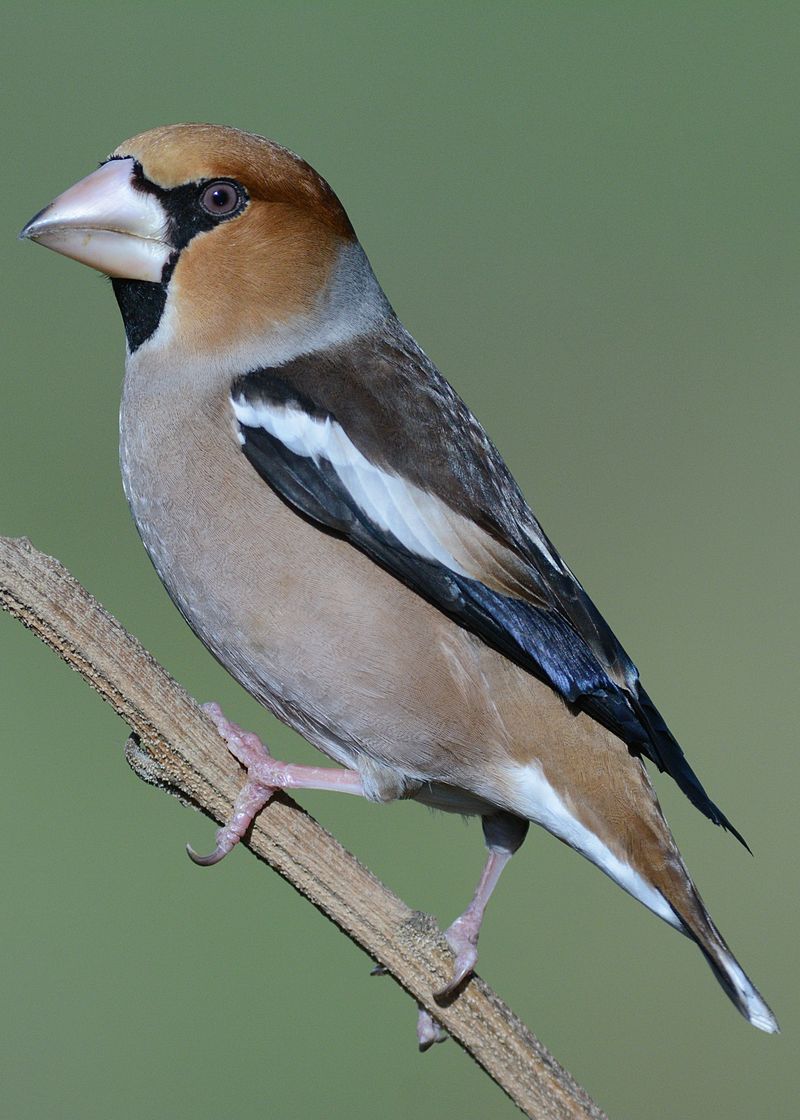
The hawfinch is a medium-sized passerine bird that belongs to the finch family, Fringillidae. It is the only species in the genus Coccothraustes. This species has four close relatives that are found in East Asia and North America.
The Chinese grosbeak and Japanese grosbeak are from East Asia, while the evening grosbeak and hooded grosbeak are from North America. All of these birds share similar traits and characteristics, such as their large, rounded bills and their colorful plumage.
The hawfinch is known for its colorful feathers, which come in shades of yellow, brown, and red. Its bill is thick and conical, and its legs are short and strong. The hawfinch feeds mainly on fruits and seeds, but it also eats insects and small invertebrates.
It is a popular bird in aviculture, and it is often kept as a pet. Its intelligence and charming personality make it an ideal companion. The hawfinch is a species of conservation concern, as its population is declining due to habitat destruction and human activities.
However, captive breeding programs are in place to help protect the species from extinction.
| Kingdom | Animalia |
| Phylum | Chordata |
| Class | Aves |
| Order | Passeriformes |
| Family | Fringillidae |
| Genus | Coccothraustes |
| Species | C. coccothraustes |
9. Eurasian Magpie

The Eurasian magpie, also known as the common magpie, is a bird species that is found across the northern parts of the Eurasian continent. It is a resident bird, meaning that it remains in the same location year-round, breeding in the same area.
It is one of many birds classified as magpies, which are members of the crow family. The Eurasian magpie belongs to the Holarctic radiation, which is made up of monochrome magpies.
The monochrome magpies are characterized by their single-color plumage, which is usually black and white. This species of magpie is very social, and often forms large flocks to forage and socialize.
They are also very intelligent and have been documented using tools and recognizing themselves in mirrors. The Eurasian magpie is a common sight in many parts of its range and is often considered a symbol of good luck.
| Kingdom | Animalia |
| Phylum | Chordata |
| Class | Aves |
| Order | Passeriformes |
| Family | Corvidae |
| Genus | Pica |
| Species | P. pica |
10. Eurasian Nuthatch

The Eurasian Nuthatch, also known as the Wood Nuthatch, is a small passerine bird native to the Palearctic and Europe. It has a short tail and a distinct long bill, as well as blue-gray upperparts and a black eye stripe.
This bird is very vocal, often making a repeated loud “dwip” call.
This call is a distinctive sound to the species and is often used by the bird to communicate with its peers. The Eurasian Nuthatch is a very active bird, often seen hopping up and down tree trunks and flying from tree to tree.
It is an agile bird, and can even climb headfirst down tree trunks. Its diet consists of insects, spiders, and small larvae, which it finds by gleaning or searching through tree bark and crevices.
It also feeds on nuts and other seeds, and will often store them in crevices or cracks in the bark for later use. The Eurasian Nuthatch is an important species for the conservation of many of Europe’s forests, as it helps to control insect populations and helps to spread tree seeds.
It is also an important indicator species, as changes in its numbers can often be an indication of changes in forest health.
Despite its importance, the Eurasian Nuthatch is still threatened by habitat loss, and its numbers have been steadily declining in certain parts of Europe.
| Kingdom | Animalia |
| Phylum | Chordata |
| Class | Aves |
| Order | Passeriformes |
| Family | Sittidae |
| Genus | Sitta |
| Species | S. europaea |
11. Western Jackdaw

Source: Wikipedia
The western jackdaw is a small, black-feathered bird belonging to the crow family. It is found across a wide range of habitats, including Europe, western Asia, and North Africa. This species is mostly resident, which means that it will stay in the same area for most of the year.
However, the northern and eastern populations may migrate south in the winter in order to escape cold weather and find more food. The western jackdaw is also known by other names, such as the Eurasian jackdaw, European jackdaw, or simply the jackdaw.
It is an omnivore, feeding on both plant and animal material. It can often be seen in gardens, parks, and fields, and is known for its loud calls and playful behavior.
| Kingdom | Animalia |
| Phylum | Chordata |
| Class | Aves |
| Order | Passeriformes |
| Family | Corvidae |
| Genus | Coloeus |
| Species | C. monedula |
12. Eurasian Jay
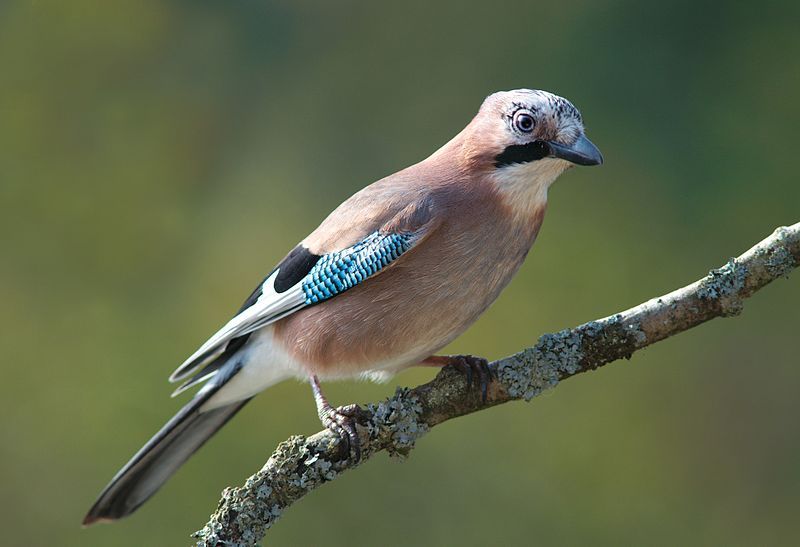
The Eurasian jay is a type of bird that belongs to the Corvidae family, which also includes crows. It has a light pinkish-brown plumage and a white throat with two black stripes on either side.
Its wings are particularly striking, with a bright blue panel running along the upper surface. Finally, its tail is a glossy black color.The Eurasian jay is a relatively large bird, measuring about 25–30 cm in length and weighing up to 75 g.
Its beak is short and powerful, allowing it to crack open hard nuts and seeds. Its feet are also strong, enabling it to climb trees and jump from branch to branch with ease. The Eurasian jay is a social bird, typically living in small groups of up to 10 individuals.
They are known to be quite vocal, with a range of different calls and songs.
They are also highly intelligent, able to remember where they have buried food and even recognize individual humans. The Eurasian jay is native to much of central and northern Europe and parts of Russia and China.
It prefers forests and woodlands, but can also be found in parks and gardens, where it feeds on insects, nuts, berries, and other small animals. It is not considered threatened, but its population is slowly declining due to habitat loss.
| Kingdom | Animalia |
| Phylum | Chordata |
| Class | Aves |
| Order | Passeriformes |
| Family | Corvidae |
| Genus | Garrulus |
| Species | G. glandarius |
13. Dunnock

The dunnock is a small bird that is found in many areas of the world. It belongs to the family of birds known as the Accentors, which are typically found in mountain habitats.
The dunnock, however, is an exception as it is found throughout much of temperate Europe, as well as Asian Russia. This makes it far more widespread than the other members of the Accentor family.
At some point, the dunnock was also introduced to New Zealand, where it has been successful in thriving. The dunnock is a small passerine bird, meaning that it has two toes pointed forward and two backward when perched on a branch.
They have a brownish-grey head, with a white eye ring, a greyish-brown back, and a pale brown underbelly. Their wings and tail are greyish-brown, with a white patch at the base of their wings.
They can typically be found in grassy meadows, gardens, hedgerows, and woodlands. The dunnock’s diet consists mostly of insects, seeds, and fruit. During the breeding season, they will also feed on spiders, worms, and snails. They will also sometimes scavenge for food.
Dunnocks can be seen in pairs or small flocks, as they are quite social birds. They are also quite vocal, with a range of different calls and songs. The dunnock is a species that is quite resilient and can adapt to different habitats.
Its success in New Zealand is a testament to this ability, and it is likely to continue to thrive in many other parts of the world.
| Kingdom | Animalia |
| Phylum | Chordata |
| Class | Aves |
| Order | Passeriformes |
| Family | Prunellidae |
| Genus | Prunella |
| Species | P. modularis |
14. Old-world Flycatchers

The Old World flycatchers (Muscicapidae) are a family of small passerine birds found in the Old World, which includes Europe, Asia, and Africa. This family of birds is composed of species that are generally restricted to the Old World region, with a few exceptions.
Two species, the bluethroat, and northern wheatear, have been found to be vagrants in North America. Flycatchers are known for their loud calls, often used to attract mates or mark territory. They usually feed on a wide variety of insects and other invertebrates.
Flycatchers come in a variety of sizes and colors, ranging from small gray and brown birds to brightly colored red, yellow, and blue species. The Old World flycatchers are an important part of the ecosystem, helping to control the population of insects.
They are also popular with birdwatchers, as they can often be seen perching on branches or flying through the air in search of food.
| Kingdom | Animalia |
| Phylum | Chordata |
| Class | Aves |
| Order | Passeriformes |
| Family | Muscicapidae |
15. Hazel Grouse
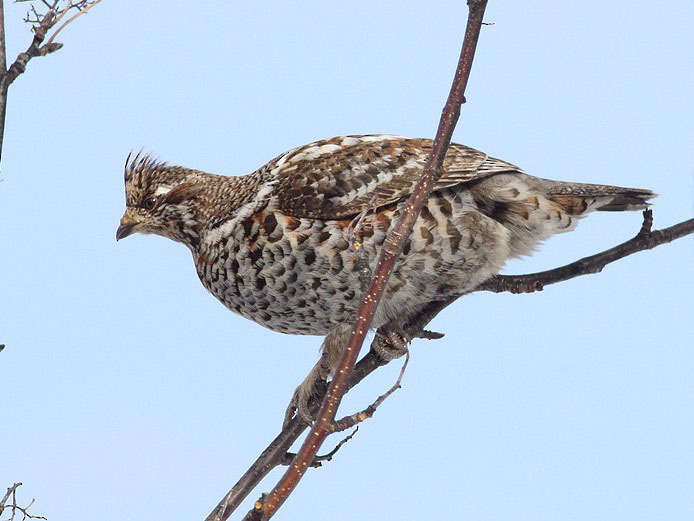
The hazel grouse, also known as the hazel hen, is a small bird that is part of the grouse family. It is not migratory, meaning it breeds and lives in the same place all year round.
Its range extends across the Palearctic region, from Europe in the west, all the way to Hokkaido in the east. The hazel grouse prefers to live in dense, damp, mixed coniferous woodland and prefers its habitat to include spruce trees.
The Palearctic region is a biogeographic region that encompasses the majority of the Northern Hemisphere, including Europe, Asia, and parts of North Africa. This makes the hazel grouse a widespread species, and it is quite adaptable to different habitats.
It prefers to live in dense, damp, mixed coniferous woodland, which includes trees such as spruce, pine, larch, fir, and cedar. These dense forests provide the hazel grouse with the perfect habitat to live and breed.
The hazel grouse is a sedentary species, meaning it does not migrate. It breeds in the same location it lives, and it will not move from its habitat during the winter. This species is well-adapted to its environment, as it can survive in both cold and warm temperatures.
This means that the hazel grouse can survive in a variety of habitats, as long as it has access to the dense, damp coniferous woodland it prefers. The hazel grouse is an important species in the Palearctic region, as it forms an integral part of the ecosystem.
It is an important food source for many predators, and it also serves as an important pollinator for the plants in its habitat. The hazel grouse is an important species, and it is important that we continue to protect its habitat and ensure its survival.
| Kingdom | Animalia |
| Phylum | Chordata |
| Class | Aves |
| Order | Galliformes |
| Family | Phasianidae |
| Genus | Tetrastes |
| Species | T. bonasia |
16. Indigo Bunting

The indigo bunting is a small bird that belongs to the cardinal family, Cardinalidae. It is a migratory bird that travels across a wide range during two different seasons. During the breeding season, it can be found in southern Canada and northern Florida.
In the winter, it migrates south to northern South America. The indigo bunting has a unique way of navigating during its migrations; it uses the stars to guide its path. This is a remarkable adaptation that allows the bird to cover long distances quickly and safely.
The indigo bunting is a fascinating species that has evolved to survive in a wide range of habitats and travel long distances through the night sky.
| Kingdom | Animalia |
| Phylum | Chordata |
| Class | Aves |
| Order | Passeriformes |
| Family | Cardinalidae |
| Genus | Passerina |
| Species | P. cyanea |
Conclusion
Bluebirds are a beautiful and iconic species found throughout Europe. They are a treasured sight in many countries and their presence is an important part of the natural environment.
Unfortunately, their population has been in decline due to habitat degradation and other environmental pressures. It is important to continue to work to protect their habitat and ensure their populations remain stable.